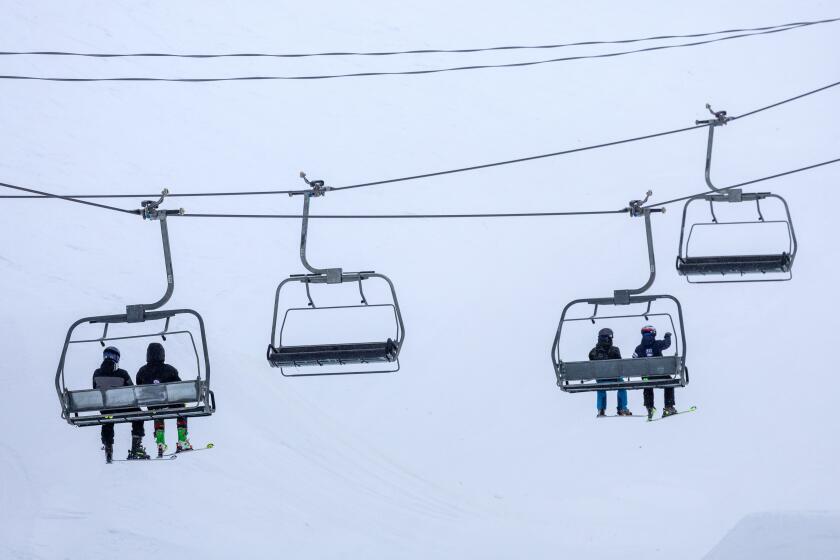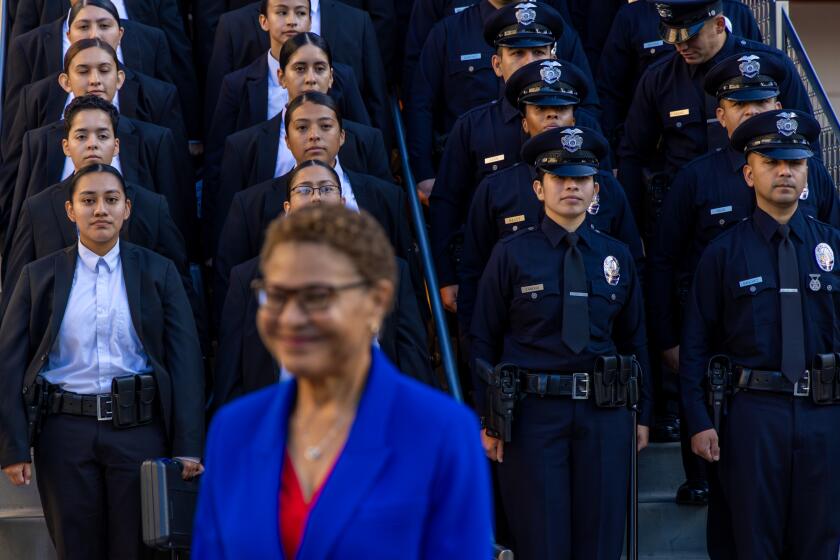Community Groups’ Free Use of Vans to End : Recovery: Agencies have become dependent on vehicles provided to RLA by GM and Hughes. But donors point out that the deal was only for a year.
- Share via
For the past year, hundreds of South-Central Los Angeles youngsters have been transported to after-school tutoring programs, museums and pro basketball games in new Chevy vans supplied without charge to a pair of boys and girls clubs by RLA.
“We’ve called it the ‘safe streets’ program,” said Lou Dantzler, director of the Challengers Boys and Girls Club, located on a crime-infested stretch of Vermont Avenue. “You should see the kids’ faces when someone picks them up after school.”
This week, however, Dantzler and his counterpart at the Watts/Willowbrook Boys and Girls Club must turn in the keys to General Motors and its subsidiary, Hughes Aircraft Co.
The firms gave a joint gift of up to 100 vans to RLA for distribution to community organizations as part of their post-riot commitment to Los Angeles--but for a limited time only.
Leaders of nonprofit agencies that received the vans acknowledge that they were asked to sign contracts that made it clear the vehicles had to be returned after a year. But many say they have become dependent on the vehicles and contend that the publicity about the terms of the program has been misleading.
To keep the vehicles longer than a year, the organizations would have to purchase them. And that, they say, is virtually impossible for most financially strapped nonprofit agencies.
“Anything is too much when you don’t have anything,” said Karen Hallerman, executive director of Chrysalis, a Downtown homeless assistance agency that is supposed to return its van in April. “It’s like a kid being given a toy and then you take the toy away.”
Although expressing reluctance to criticize a gift, several recipients say the short-term program epitomizes the shortsighted strategies that have emerged for rebuilding the county’s riot-scarred neighborhoods.
In the wake of last year’s civil unrest, then-Mayor Tom Bradley and other government leaders turned to the private sector to cope with the crisis, asking businessman Peter V. Ueberroth to head the recovery effort. The resulting nonprofit organization, originally known as Rebuild L.A., vowed to revitalize neglected neighborhoods in large part by encouraging the business community to create new jobs and economic opportunities.
Over time, major corporations have been publicly hailed by RLA for making $585 million in investment pledges. But, except for expansion programs announced by three major supermarket firms, only about 10% of the amount has gone to job or business development that would have a major, long-term impact on the economy of impoverished communities.
“It’s only putting a Band-Aid on the problems, that’s all,” Dantzler said. “You need a surgeon on these problems.”
Dantzler added that RLA’s publicity could have been clearer about the terms of the van program. “They should have put in fine print: ‘Vans will be repossessed after one year,’ ” he said.
*
Oscar Andrade of El Rescate agrees. “They got all the publicity, all the tax breaks and now they want to get them back,” said Andrade, who heads the service organization for Central American immigrants. “It’s too short term and that’s really bad.”
The GM-Hughes-RLA news release announcing the program in July, 1992, made no reference to a time limit. It stated that the firms’ post-riot commitment was to include “one hundred GM vehicles to be made available to RLA to assist education and community organizations.”
“It said ‘made available’ rather than ‘donate’ or ‘give,’ ” pointed out Hughes spokesman Richard Dore this week.
The wording in RLA’s first-year review went further. It said that GM and Hughes “donated, as part of its larger program, a total of 100 vans and trucks to RLA for use by community groups.” RLA officials said last week they could not explain why they used that wording.
At the last quarterly meeting of RLA’s board of directors, the van program was attacked by board member Herb Carter, president and chief executive officer of the United Way of Greater Los Angeles.
“It is, I think, just absolutely asinine that we would loan a van to a small agency for a year and after they get accustomed to it, then take it way from them because they can’t afford to buy it,” said Carter. “I think that’s bad business for RLA.”
Unless there are changes in the program, Carter said, he plans “to recommend that we get out of that business altogether.”
RLA Co-Chairman Tony Salazar replied that he and other RLA officials also had concerns and added that the agency was seeking modifications. But RLA officials have not detailed what efforts have been made.
And this week, a GM spokesman said there will be no changes in the one-year loan period.
“We are extremely proud of the role we’ve played as a good corporate citizen by coming forth with this program,” said spokesman Carl Sheffer. “There have been vehicles loaned to organizations and when those organizations signed the agreements they knew the vehicles would be made available--not donated or given--for up to a year.”
He bristled at Carter’s criticism. “I have to be honest and candid and say if someone said there are problems, I don’t quite understand that,” Sheffer said. “I’d say the program has worked extremely well.”
*
Thus far, 62 vans retailing for about $20,000 each have been loaned for 12 months each to community groups across Los Angeles. Insurance, repair and registration costs were also picked up by the corporate sponsors. The remaining vans, which carry up to nine passengers, will be distributed in coming months, Sheffer said.
The van program came in addition to a pledge of more than $18 million in post-riot aid for economic development and community support programs by GM and Hughes. Those programs, including a promise by Hughes to increase its contract awards to minority-owned suppliers, are continuing, a spokesman said.
RLA delivered the first three vans in October, 1992, and at least one of the recipients, the Boys and Girls Club of the San Fernando Valley, has already returned the keys. Club director LeRoy Chase said the van was used to transport youngsters to counseling sessions and other club activities.
“Transportation is very important here,” said Chase. “Many youngsters cross into different turfs and with a van with the Boys and Girls Club name on the side, it was a neutral vehicle in which youngsters and parents could feel very comfortable.”
Since returning the van, the club has been forced to scramble to keep its outreach programs running.
“Sometimes, when you receive a gift for a short period of time you greatly appreciate it but have a tendency to create programs,” Chase said. “And when all of a sudden you have to cut back, it’s very detrimental.”
Ten more vans are due back this week.
“They wanted to sell it to us for $14,000 or $16,000, but we don’t have that kind of money,” said Dantzler.
*
Roy Roberts II, director of the Watts/Willowbrook Boys and Girls Club, said, “I don’t want to knock RLA, General Motors or Hughes. They tried to provide some immediate help. I understand that and really appreciate it.”
At El Rescate, Andrade said that his staff may have to rely on a pickup to transport clients once the van is turned in this week.
And at the Dolores Mission on the Eastside, Cynthia Bernal hopes that the return of two Chevy vans early next year will not jeopardize a fledgling business created to develop jobs for ex-gang members.
For several months, Bernal said, the vans have served as delivery trucks for Homeboy Industries, which bakes breads and tortillas for supermarkets and specialty bakeries.
“The vans are very central to our operation. We’re very grateful we have them and we don’t want to let go of them,” said Bernal, associate director of Proyecto Pastoral of Dolores Mission, the agency that supervises Homeboy.
“The events of April, 1992, stimulated a very knee-jerk reaction,” Bernal said. “There was a very automatic, sometimes superficial reaction. In order to deal with those issues really effectively on a deep, deep level, you have to make a much larger commitment to the improvement of Los Angeles.”
More to Read
Sign up for Essential California
The most important California stories and recommendations in your inbox every morning.
You may occasionally receive promotional content from the Los Angeles Times.










